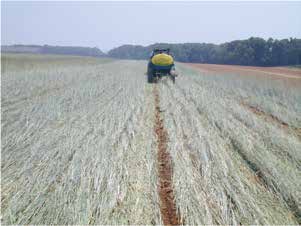chAPter 16 reduCing tillage
Jethro tuLL And tILLAGe: A MIxed LeGAcY And An IMPortAnt Lesson
Jethro Tull (1674–1741) was an early English agricultural experimentalist whose book The New Horse Hoeing Husbandry: An Essay on the Principles of Tillage and Vegetation was published in 1731. It was the first textbook on the subject and set the standard for soil and crop management for the next century (it is now available online as part of core historical digital archives; see “Sources” at the end of the chapter). In a way, Tull’s publication was a predecessor to this book, as it discussed manure, rotations, roots, weed control, legumes, tillage, ridges, and seeding.
Tull noticed that traditional broadcast sowing methods for cereal crops provided low germination rates and made weed control difficult. He designed a drill with a rotating grooved cylinder (now referred to as a coulter) that directed seeds to a furrow and subsequently covered them to provide good seed-soil contact. Such row seeding also al owed for mechanical cultivation of weeds, hence the title of the book. This was a historical y significant invention, as seed drills and planters are now key components of conservation agriculture and building soils. But the concept of growing crops in rows is attributed to the Chinese, who used it as early as the 6th century B.C.E.
Tull believed that intensive tillage was needed not only for good seed-soil contact but also for plant nutrition, which he believed was provided by small soil particles. He grew wheat for thirteen consecutive years without adding manure; he basical y accomplished this by mining the soil of nutrients that were released from repeated soil pulverization. He therefore promoted intensive tillage, which we now know has long-term negative consequences. Perhaps this was an important lesson for farmers and agronomists: Practices that may appear beneficial in the short term may turn out detrimental over long time periods.
from the next one. In temperate or wet regions the hills
generally less prone to erosion than whole-field tillage,
were elevated to provide a temperature and moisture
but climate and soil conditions on steep slopes still
advantage to the crop. In contrast with the cereal-based
frequently caused considerable soil degradation.
systems (wheat, rye, barley, rice) of growing only one
A third ancient tillage system was practiced as part
crop in a monoculture, these fields often included the
of the rice-growing cultures in southern and eastern
intercropping of two or three plant species growing at the
Asia. There, paddies are tilled to control weeds and
same time, like the corn, bean, and squash of the Three
puddle the soil to create a dense layer that limits down-
Sisters system in North America. This hilling system was
ward losses of water through the soil. The puddling
process occurs when the soil is worked while wet—in the
plastic or liquid consistency state; see chapter 6—and
technoLoGIes thAt hAve Lessened
is specifically aimed at destroying soil aggregates. This
the need for tILLAGe…
system was designed to benefit rice plants, which thrive
• herbicides
under flooded conditions, especially relative to compet-
• new zone and strip tillage tools that provide tar-
ing weeds. There is little soil erosion, because paddy
geted decompaction
rice must be grown either on flat or terraced lands, and
• new planters and transplanters
runoff is controlled as part of the process of growing the
• new methods for cover crop management
crop. Recent research efforts have focused on less pud-
dling and ponding to conserve soil health and water.
174
Building SoilS for Better CropS: SuStainaBle Soil ManageMent





